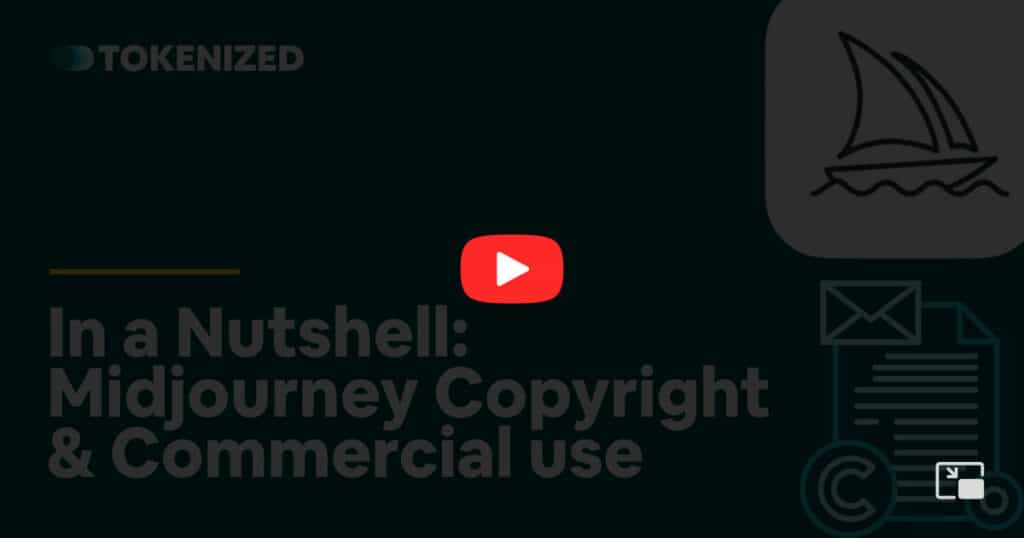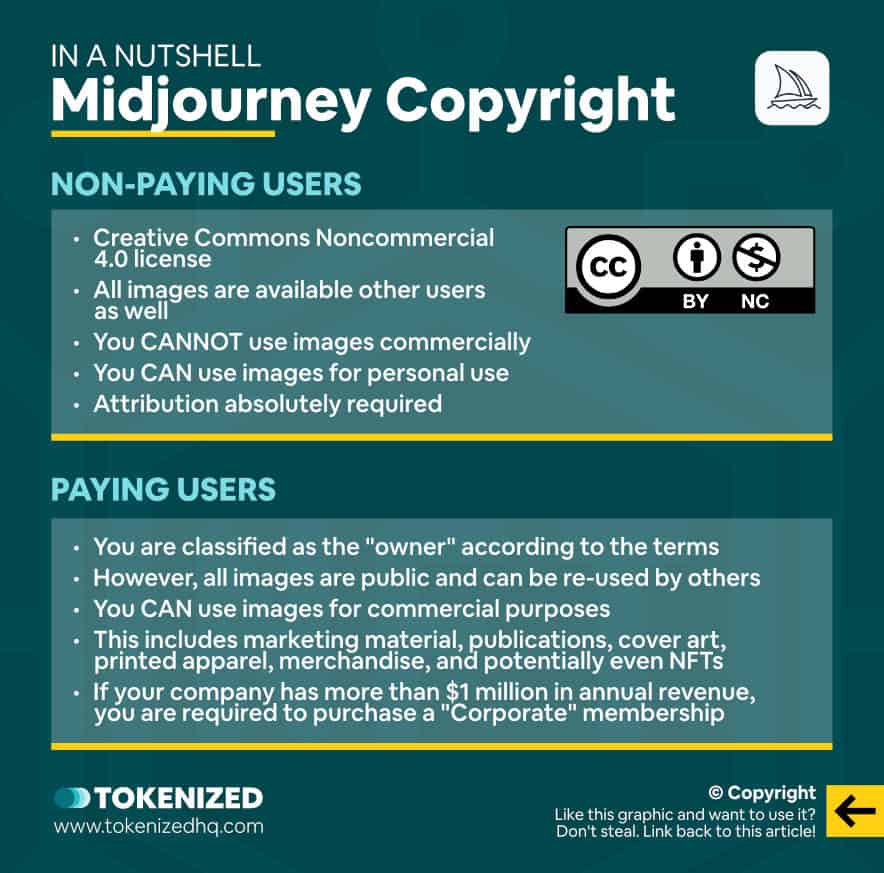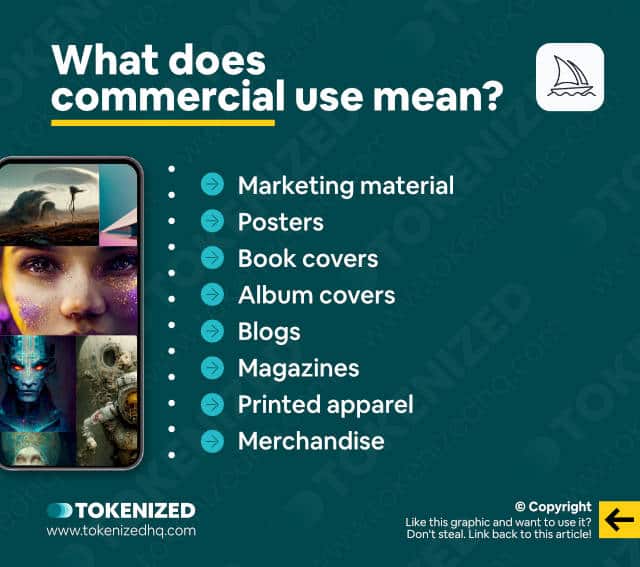Are you confused about the Midjourney copyright terms?
Perhaps you were considering becoming a paying subscriber of Midjourney but you’d like to get a better understanding of what you’re allowed to do and what not?
Well, to be honest, there’s still a lot of debate around how AI technology will impact copyright laws but we’ve done our best to summarize how Midjourney’s terms of server work (on paper).
In this guide, you’ll learn how the Midjourney copyright terms work and what you can and cannot do with your images.
Let’s dive right in.
Key Points (tl;dr)
- Non-paying users are granted a Creative Commons Noncommercial 4.0 asset license, meaning that they can use the images for personal projects as long as they give visible attribution.
- Paying users are classified as “owners” of the assets they create and can use them for whatever commercial purposes they choose.
- Despite “owning” the images, Midjourney’s terms also indirectly “force” you to allow anyone else to use your public images as well.
For a detailed explanation of how Midjourney copyright works and whether commercial use is allowed, PLEASE READ THE FULL ARTICLE.

Like this content? Then share it!
In a Nutshell: Midjourney Copyright & Commercial Use
www.tokenizedhq.com
Here’s the answer. Great article by @ChrisHeidorn right here: https://tokenizedhq.com/midjourney-copyright-commercial-use/
Midjourney Copyright In a Nutshell

Before we get into the details of how Midjourney’s terms around copyright and trademark work, it’s important to understand the philosophy behind Midjourney’s product.
Midjourney aims to create a collaborative space where everyone is creating different pieces of art which are shared with the community.
In other words, Midjourney promotes the sharing and recycling of other users’ Midjourney images because this help continuously improves the AI over time.
The vast majority of users’ images are publicly visible to everyone and can be re-used by anyone to create new images.
Once you understand this philosophy, you’ll no longer be surprised that Midjourney’s terms of server essentially state the following.
Midjourney’s Rights:
- Perpetual, non-exclusive, and worldwide rights.
- The right to sublicense, reproduce and prepare derivative works.
- Rights to publicly display, perform, and distribute images and text prompts.
Your Rights:
- You “own” all the assets created with Midjourney.
- However, they can still be used and remixed by others.
- You can use the images commercially, provided you are a paid user.
I know some of this may seem confusing but it essentially states that everything you create with Midjourney can be used by Midjourney and anyone else as well.
And depending on whether you’re a free or a paying user, you are granted different levels of usage rights.
Rights of Non-Paid Users
Under the Midjourney copyright terms, non-paying users are granted an asset license under the Creative Commons Noncommercial 4.0 Attribution license.
What that means is that you can do whatever you want with the images as long as it is not for commercial purposes.
Furthermore, you need to give attribution to Midjourney.
Rights of Paid Users
For paid users, the rules are fairly simple.
You’re essentially allowed to do whatever you want with the images you create.
The only exception to this is if you created the images for a company with more than $1 million in annual revenue.
If you fall into that category then you’ll need to subscribe to Midjourney’s corporate membership.
What Does Commercial Use Mean?

Commercial use in the context of Midjourney means that you can use it for business purposes, as long as you do not fall into the “corporate” category.
Business purposes include but are not limited to:
- Marketing material
- Posters
- Book covers
- Album covers
- Printed apparel
- Merchandise
We hesitate to list NFTs here, simply because the AI and blockchain scenes are still very new and a lot of legal questions haven’t been clarified yet.
Technically, one could argue that the NFT itself is the entry on the blockchain, while the artwork is part of the visual brand and marketing.
In that context, using Midjourney artwork for NFTs would be fine, however, it also makes it impossible to legally stop someone else from using the same artwork.
Copyright Works Differently Around the World
Just as a little side note, I’d like to point out that the way copyright is often handled in the US is vastly different from other jurisdictions.
It’s fairly common, at least colloquially, to transfer copyright to someone.
In many European countries, that is not possible because the copyright always remains with the original creator in perpetuity.
Instead, you can sell or transfer rights to a piece of work.
This is particularly important in the context of AI artwork, given that it’s unclear whether the AI should be classified as the “artist” or not.
Frequently Asked Questions (FAQ)
Before we close off this guide, let’s quickly address some of the most common questions related to Midjourney copyright and commercial use.
-
Can I use Midjourney commercially?
Yes, if you are a paying member then you can use images created with Midjourney for any business purpose. You can use it for marketing material, as cover art, and even print it on merchandise and sell it.
-
Is Midjourney royalty-free?
Images created with Midjourney are royalty-free. That means that your usage rights are effectively paid by your membership fee. No additional fees or royalties are due once you use the artwork, no matter how often it is used or how much you charge for it.
-
Are Midjourney images free to use?
If you are a non-paid user, the Midjourney copyright terms grant you a Creative Commons Noncommercial 4.0 license. This means you must give clearly visible attribution whenever you use the artwork.
-
Who owns the copyright on Midjourney text prompts?
Copyright law experts are still in disagreement as to whether text prompts have sufficient “creative level” to be considered for copyright, especially given how short and generic they are. That being said, the Midjourney terms of service are fairly clear on the fact that by inputting them into the tool, you are effectively granting everyone the right to use them as well. So the answer is somewhat irrelevant.
Conclusion
Copyright and trademark laws have always been a bit of a headache and with the advent of artificial intelligence, it’s only getting worse.
The Midjourney copyright terms can be confusing for some people but as long you’re a paying member you’ve nothing to worry about and can do whatever you want.
However, it’s also important to understand that even though you are classified as the “owner”, you indirectly also grant any other user the right to remix and use the images you create.
Here at Tokenized, we want to help you learn as much as possible about the AI software industry. We help you navigate the world of tech and the digitalization of our society at large, including the tokenization of assets and services.



